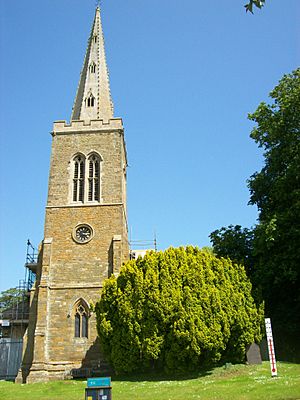All Saints' Church, Naseby facts for kids
Quick facts for kids All Saints' Church, Naseby |
|
|---|---|
 |
|
| 52°23′49″N 0°59′20″W / 52.39688°N 0.98895°W | |
| Denomination | Church of England |
| Administration | |
| Parish | Naseby |
| Deanery | Brixworth |
| Archdeaconry | Northampton |
| Diocese | Peterborough |
| Province | Canterbury |
All Saints' Church is a historic Anglican Church located in Naseby, a village in Northamptonshire, England. It serves as the main church for the local community. This beautiful building is recognized as a Grade II* listed building, meaning it's a very important historical structure. You can find it at the corner of Church Street and Newlands.
Contents
A Look Back: The Church's History
Early Days and Saxon Clues
People believe there was a church in Naseby as far back as 1086. The Domesday Book, a famous survey from that time, mentions a priest living there. Even though the book doesn't directly say "there's a church building," it suggests one existed. We know there was an even older church before the Norman Conquest of 1066. Some ancient Saxon stones are built right into the walls of the church you see today. There's also an old grave slab carved into the tower wall.
Building the Church We See Today
Most of the church building you see now was constructed in the 1200s and 1300s. It's mostly made from strong, rough stone called lias rubble and smoother lias ashlar, with a slate roof. The church has a main hall called a nave, with windows high up (a clerestory). It also has side sections called north and south aisles, a chancel (the area around the altar), and a tall west tower.
The south aisle, its pillars, and wall were built first, around 1220 to 1240. The north aisle was added later, around 1280. The high windows above the arches on both sides of the nave were built around 1400.
Changes Over the Centuries
Over time, the church has seen some updates. In the 1700s, the lower parts of the north aisle pillars were covered with new, classical-style bases. The chancel was rebuilt in 1830.
The church's tower was likely built in the 1300s. The tall, pointed spire on top was added much later, in 1859–60. It was designed by an architect named William Slater. It seems the medieval builders left the spire unfinished, like a stump. In the 1700s, it had a very unusual top: a large copper ball on a central pole with four supports, topped by a weather vane. A local historian, John Mastin, said this copper ball was treasure brought to England in 1544.
Cromwell's Table: A Battle Story
Inside the north aisle, you can find a 17th-century table known as "Cromwell's Table." It's believed to have come from Shuckburgh House, which is across from the church.
The story goes that on the night before the famous Battle of Naseby in 1645, some of the king's soldiers were having supper at this very table. Suddenly, Oliver Cromwell's troops surprised them! Several royal soldiers were killed, and the rest were captured. After their fight, Cromwell's men supposedly sat down at the table and finished the meal.
Modern Use and Community Hub
In 2013, there were plans to open a visitor and community center inside part of the church building. This would help the Naseby Battlefield Trust teach more people about the Battle of Naseby. It would also keep the church as an active place of worship with modern facilities for everyone.
Church Records and Memorials
The church's old records, called parish registers, go all the way back to 1563. These important historical documents are now kept safe at the Northamptonshire Record Office.
Inside the church and in its graveyard, you can find many memorials. These include a brass plaque for John Oliyver, who passed away in 1446, and his wife. There's also an oval tablet remembering Rev John Mastin, the vicar and historian.
Naseby Church is part of a group of churches called a "united Benefice." This group also includes the churches in Clipston, Haselbech, and Kelmarsh.

